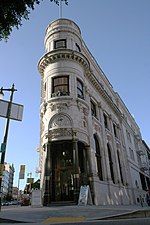Black Cat Bar
The Black Cat Bar or Black Cat Café was a bar in San Francisco, California. It originally opened in 1906 and closed in 1921. The Black Cat re-opened in 1933 and operated for another 30 years. During its second run of operation, it was a hangout for Beats and bohemians but over time began attracting more and more of a gay clientele, and becoming a flashpoint for what was then known as the homophile movement, a precursor to the gay liberation movement that gained momentum in the 1960s. The Black Cat was at the center of a legal fight that was one of the earliest court cases to establish legal protections for gay people in the United States. Despite this victory, continued pressure from law enforcement agencies eventually forced the bar's closure in 1964.
Excerpt from the Wikipedia article Black Cat Bar (License: CC BY-SA 3.0, Authors).Black Cat Bar
Montgomery Street, San Francisco
Geographical coordinates (GPS) Address Nearby Places Show on map
Geographical coordinates (GPS)
| Latitude | Longitude |
|---|---|
| N 37.795818 ° | E -122.403257 ° |
Address
Montgomery Street 708;710
90104 San Francisco
California, United States
Open on Google Maps






